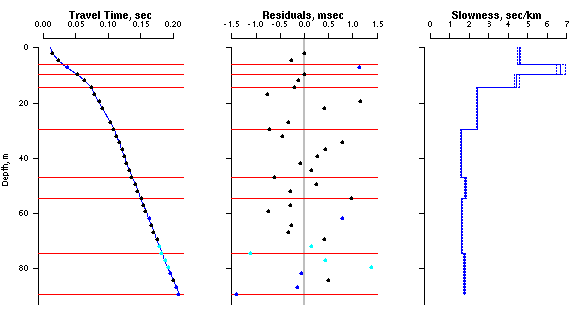Earthquake Hazards Program

This report discusses a method for interpreting a layered slowness or velocity model from surface-source downhole seismic data originally presented by Boore (2003). I have implemented this method in the statistical computing language R (R Development Core Team, 2007), so that it is freely and easily available to researchers and practitioners that may find it useful. I originally applied an early version of these routines to seismic cone penetration test data (SCPT) to analyze the horizontal variability of shear-wave velocity within the sediments in the San Francisco Bay area (Thompson et al., 2006). A more recent version of these codes was used to analyze the influence of interface-selection and model assumptions on velocity/slowness estimates and the resulting differences in site amplification (Boore and Thompson, 2007). The R environment has many benefits for scientific and statistical computation; I have chosen R to disseminate these routines because it is versatile enough to program specialized routines, is highly interactive which aids in the analysis of data, and is freely and conveniently available to install on a wide variety of computer platforms.
These scripts are useful for the interpretation of layered velocity models from surface-source downhole seismic data such as deep boreholes and SCPT data. The inputs are the travel-time data and the offset of the source at the surface. The travel-time arrivals for the P- and S-waves must already be picked from the original data. An option in the inversion is to include estimates of the standard deviation of the travel-time picks for a weighted inversion of the velocity profile. The standard deviation of each travel-time pick is defined relative to the standard deviation of the best pick in a profile and is based on the accuracy with which the travel-time measurement could be determined from the seismogram.
The analysis of the travel-time data consists of two parts: the identification of layer-interfaces, and the inversion for the velocity of each layer. The analyst usually picks layer-interfaces by visual inspection of the travel-time data. I have also developed an algorithm that automatically finds boundaries which can save a significant amount of the time when analyzing a large number of sites. The results of the automatic routines should be reviewed to check that they are reasonable. The interactivity of these scripts allows the user to add and to remove layers quickly, thus allowing rapid feedback on how the residuals are affected by each additional parameter in the inversion. In addition, the script allows many models to be compared at the same time.
Download the text for this report as a 17-page PDF file (of2007-1124.pdf; 320 kB)
Download the install package for Unix variants (including Mac OS-X) (Rvelslant_0.2-3.tar.gz; 56 kB)
Download the install package for Microsoft Windows operating systems (Rvelslant_0.2-3.zip; 56 kB)
For questions about this report, contact Eric Thompson (eric.thompson@tufts.edu) or Rob Kayen (rkayen@usgs.gov).
Suggested citation and version history
| Help | Publications main page | Western Open-File Reports for 2007 |
| Geology | Earthquake Hazards Program |
This report is available only on the Web